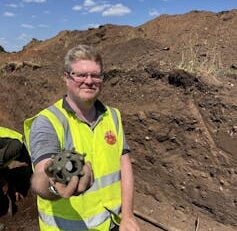
Beautifully crafted Roman dodecahedron discovered in Lincoln – but what were they for?
Roman dodecahedra are something of an enigma: there is no known mention of these 12-sided, hollow objects in ancient Roman texts or images. First discovered in the 18th century, around 130 dodecahedra have been found across the Roman Empire, although it is interesting that the majority have been found in northern Europe and Britain, and none have been found in Italy.
Dodecahedra are quite intricate, featuring a number of round holes, with knobs framing the holes. It would have taken a very skilled craftsman to make them. They are made out of a copper alloy and would have been quite expensive, due to the amount of time and metal that was used to create them, which adds to their intrigue.
I am part of the local archaeology group behind the recent discovery of a Roman dodecahedron in Norton Disney, near Lincoln. It has been quite a whirlwind for our group, from the shock on the day of finding the object, where everyone on site was buzzing with excitement and disbelief, to dealing with all the attention both nationally and internationally. It has been wonderful to witness the interest in our find and the history of Norton Disney.
There have been numerous suggestions by archaeologists and the public as to what dodecahedra could have been. Some theorise that they were religious objects, knitting tools, measuring instruments or stress toys. Due to the high level of skill involved, some have suggested that they were a way for a master craftsman to demonstrate their expert abilities.
There is no uniformity in the size or shape of the dodecahedra found so far, nor in their metal composition or even in the level of craftsmanship. If they were important objects, we would expect to also discover contextual evidence in the archaeological record, such as depictions in paintings or mosaics. It does feel that this object will remain a mystery for some time – which might be why so many people are fascinated by it.
The Norton Disney dodecahedron
In June 2023, the Norton Disney Archaeology Group (NDAG) (of which I am the treasurer) carried out a local community dig in a field close to the village of Norton Disney, Lincolnshire.
Richard Watts, who found the dodecahedron.
Norton Disney Archaeology Group
Four trenches were opened, and it was in trench four – in what appeared to be a large pit – that a perfectly crafted dodecahedron was found. It’s the 33rd to be found in England and the first to be found in the Midlands.
There are a few things that make this find particularly special. First is its size, as it is thought to be one of the largest examples in Britain. Second is the high level of preservation of the object. As Richard Parker, the secretary for the NDAG, explained: “Ours is in absolutely fantastic condition. It is completely undamaged and there is no evidence of any wear at all.”
The dodecahedron has undergone some initial analysis in order to try to provide some more clues about it. A handheld XRF (X-Ray flourescence) analysis, a technique used to analyse element composition, was carried out by archaeometallurgist Gerry McDonnell, an expert in the past use and production of metals by humans. It revealed that the composition of the object was mostly a mix of copper alloy (75%), with tin (7%) and lead (18%).
The Norton Disney dodecahedron measures around 8cm across and weighs 245 grams. It has also been scanned using a 3D scanner in collaboration with the University of Lincoln, and later this year it will be sent to Newcastle University for some further scientific analysis.
The Norton Disney Archaeology Group excavating trench four.
Norton Disney Archaeology Group
The site of the find itself is interesting. Pottery shards from a number of the trenches ranged in date from the Iron Age up to the Roman period, showing a long, continued use of the land.
There is also a Roman Villa close to the site that was excavated in 1935. Skeletal remains found at the villa suggest that it was occupied in the late Roman period, and that the villa site was later reused as a burial ground. In 1989, a metal detectorist discovered a Romano-British horseman deity figurine in the vicinity of the Roman villa, which is currently housed at the British Museum.
There is still so much to learn about the site and the dodecahedron itself. The trench where it was found was not fully excavated in 2023 due to time and financial constraints (the NDAG is solely reliant on donations), as it was found on the penultimate day of the dig.
But the NDAG will be returning to the site this June to reopen a couple of trenches and fully excavate the pit where the dodecahedron was found. This will hopefully provide a better picture of exactly what the site was used for and why the mysterious dodecahedron was placed there. Läs mer…